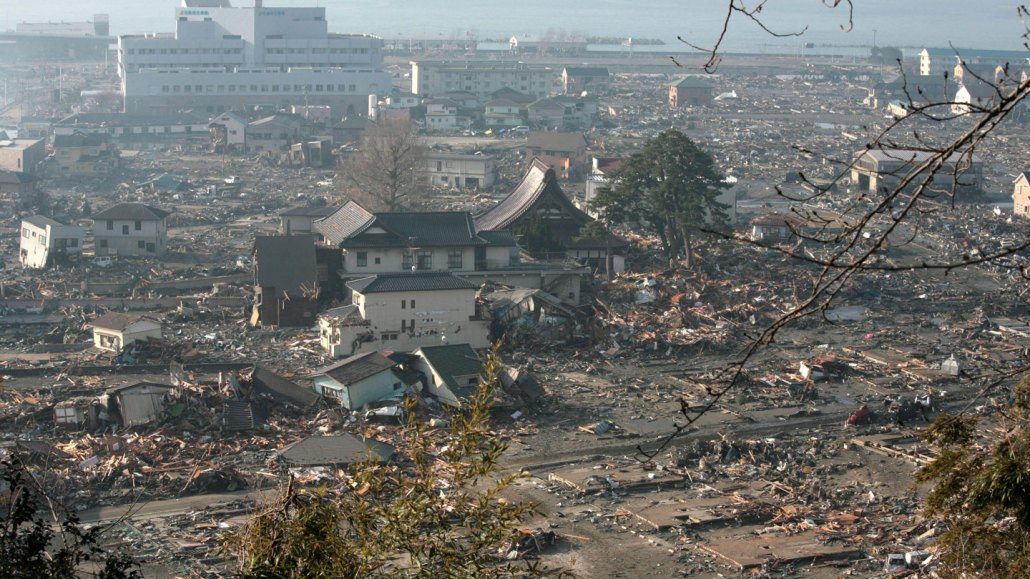Machine learning and gravity signals could rapidly detect big earthquakes
Monitoring speed-of-light changes in Earth’s gravitational field could speed up hazard warnings

A magnitude 9 earthquake struck off the coast of Japan in 2011, triggering a tsunami that devastated much of the country’s coast, including the city of Otsuchi (shown). Scientists are developing an early warning system that uses AI to detect gravity signals generated almost instantaneously by quakes.
Toshiharu Kato/Japanese Red Cross/IFRC/Getty Images
- More than 2 years ago
Massive earthquakes don’t just move the ground — they make speed-of-light adjustments to Earth’s gravitational field. Now, researchers have trained computers to identify these tiny gravitational signals, demonstrating how the signals can be used to mark the location and size of a strong quake almost instantaneously.
It’s a first step to creating a very early warning system for the planet’s most powerful quakes, scientists report May 11 in Nature.
Such a system could help solve a thorny problem in seismology: how to quickly pin down the true magnitude of a massive quake immediately after it happens, says Andrea Licciardi, a geophysicist at the Université Côte d’Azur in Nice, France. Without that ability, it’s much harder to swiftly and effectively issue hazard warnings that could save lives.
As large earthquakes rupture, the shaking and shuddering sends seismic waves through the ground that appear as large wiggles on seismometers. But current seismic wave–based detection methods notoriously have difficulty distinguishing between, say, a magnitude 7.5 and magnitude 9 quake in the few seconds following such an event.
That’s because the initial estimations of magnitude are based on the height of seismic waves called P waves, which are the first to arrive at monitoring stations. Yet for the strongest quakes, those initial P wave amplitudes max out, making quakes of different magnitudes hard to tell apart.
But seismic waves aren’t the earliest signs of a quake. All of that mass moving around in a big earthquake also changes the density of the rocks at different locations. Those shifts in density translate to tiny changes in Earth’s gravitational field, producing “elastogravity” waves that travel through the ground at the speed of light — even faster than seismic waves.
Such signals were once thought to be too tiny to detect, says seismologist Martin Vallée of the Institut de Physique du Globe de Paris, who was not involved in the new study. Then in 2017, Vallée and his colleagues were the first to report seeing these elastogravity signals in seismic station data. Those findings proved that “you have a window in between the start of the earthquake and the time at which you receive the [seismic] waves,” Vallée says.
But researchers still pondered over how to turn these elastogravity signals into an effective early warning system. Because gravity wiggles are tiny, they are difficult to distinguish from background noise in seismic data. When scientists looked retroactively, they found that only six mega-earthquakes in the last 30 years have generated identifiable elastogravity signals, including the magnitude 9 Tohoku-Oki earthquake in 2011 that produced a devastating tsunami that flooded two nuclear power plants in Fukushima, Japan (SN: 3/16/11). (A P wave–based initial estimate of that quake’s magnitude was 7.9.)
That’s where computers can come in, Licciardi says. He and his colleagues created PEGSNet, a machine learning network designed to identify “Prompt ElastoGravity Signals.” The researchers trained the machines on a combination of real seismic data collected in Japan and 500,000 simulated gravity signals for earthquakes in the same region. The synthetic gravity data are essential for the training, Licciardi says, because the real data are so scarce, and the machine learning model requires enough input to be able to find patterns in the data.
Once trained, the computers were then given a test: Track the origin and evolution of the 2011 Tohoku quake as though it were happening in real time. The result was promising, Licciardi says. The algorithm was able to accurately identify both the magnitude and location of the quake five to 10 seconds earlier than other methods.
This study is a proof of concept and hopefully the basis for a prototype of an early warning system, Licciardi says. “Right now, it’s tailored to work … in Japan. We want to build something that can work in other areas” known for powerful quakes, including Chile and Alaska. Eventually, the hope is to build one system that can work globally.
The results show that PEGSNet has the potential to be a powerful tool for early earthquake warnings, particularly when used alongside other earthquake-detection tools, Vallée says.
Still, more work needs to be done. For one thing, the algorithm was trained to look for a single point for an earthquake’s origin, which is a reasonable approximation if you’re far away. But close-up, the origin of a quake no longer looks like a point, it’s actually a larger region that has ruptured. If scientists want an accurate estimate of where a rupture happened in the future, the machines need to look for regions, not points, Vallée adds.
Bigger advances could come in the future as researchers develop much more sensitive instruments that can detect even tinier quake-caused perturbations to Earth’s gravitational field while filtering out other sources of background noise that might obscure the signals. Earth, Vallée says, is a very noisy environment, from its oceans to its atmosphere.
“It’s a bit the same as the challenge that physicists face when they try to observe gravitational waves,” Vallée says. These ripples in spacetime, triggered by colossal cosmic collisions, are a very different type of gravity-driven wave (SN: 2/11/16). But gravitational wave signals are also dwarfed by Earth’s noisiness — in this case, microtremors in the ground.






